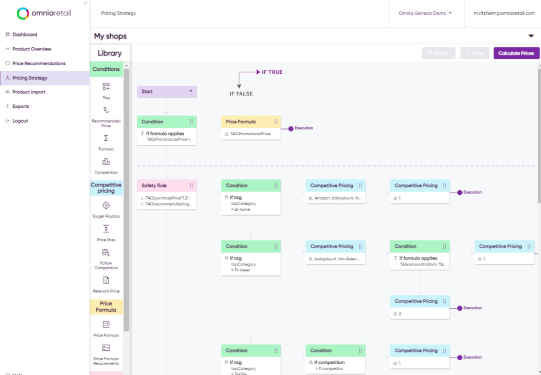Amazon's Prime Day 2025 concluded last week, marking its longest duration yet, spanning four days from July 8 to July 11. The extended event was positioned by Amazon as another record-breaking success, with early industry reports acknowledging its expanded sales footprint.
However, for pricing teams and retail analysts, the true measure of Prime Day's impact extends beyond initial headlines. This year's event prompts a deeper inquiry into the actual efficacy of advertised deals, the strategic pricing maneuvers employed by Amazon, the reactive dynamics among European competitors, and the growing legal scrutiny facing promotional pricing practices. This post will dissect these key points to provide a more comprehensive understanding of Prime Day 2025's impact on retailers.
Missing Prime Day Numbers: Amazon Withholds Key Metric
Despite Amazon's declaration of Prime Day 2025 as a "record-breaking event", as was anticipated given its extension to four days, the company refrained from releasing a crucial metric: the total number of items sold. In prior years, Amazon publicly shared these figures, reporting over 375 million items sold in 2023, 300 million in 2022, and 250 million in 2021. No comparable statement was released for the most recent event.
This decision to withhold an important KPI has drawn attention from across the industry. Experts offer a nuanced perspective on the "record sales" claims. Such record sales were entirely anticipated given the extended four-day format, with experts noting that "Anything else would be a big disappointment." Early data initially indicated a 41% decrease in Amazon sales on the first day compared to 2024's opening day, though later analysis predicted a 4.9% total sales growth for the expanded event compared to the combined 2024 Prime Day and subsequent two days. While the extension did result in greater total sales volume, it paradoxically led to lower daily average sales compared to the previous year, notably benefiting Amazon by expanding opportunities for advertising revenue.
For analysts and observers who traditionally rely on such data to gauge the event's actual success against its public communication, this opacity fuels a critical question: if a fundamental sales metric is being guarded, how truly impactful were the advertised deals? Ultimately, for Amazon, the underlying success of Prime Day is measured less by specific item counts and more by its capacity to onboard new Prime subscribers or enhance the shopping engagement of its existing subscriber base.
Key Insights into Prime Day 2025 Pricing: What the Data Says
With a global Prime membership exceeding 200 million, Amazon's influence during Prime Day is substantial, positioning it as an important event for both consumers and competitive retailers. Our analysis of the European market provides several insights into the pricing strategies employed.
Here is a breakdown of market insights and Omnia-exclusive data directly for our data team:
- Hero Products vs. Long-Tail Items: Top-selling, high-visibility "hero products" such as the Ring Video Doorbell and Sony headphones generally received more significant discounts. This approach contrasts with lower-demand, "long-tail" items, often from third-party sellers, which experienced less aggressive price reductions. This strategic differentiation enables Amazon to leverage well-known brands to drive traffic while optimizing margins across a broader product assortment, a strategy often critical for winning the marketplace Buy Box.
- European Arbitrage and Market Trends: The EU's single market inherently facilitates cross-border pricing arbitrage, allowing European consumers to compare deals across various national Amazon sites (e.g., Netherlands, Germany, France) to secure the lowest prices. This dynamic is a critical consideration for pan-European pricing strategies. In the Home & Kitchen category, success was notably driven by high-demand appliances, specifically products that fit into current lifestyle trends and or had viral moments on social media. Globally, Amazon's promotional localization efforts ensure offers align with specific regional demands and purchasing power.
- Amazon's Ecosystem Promotion: Prime Day serves as a critical platform for Amazon to bolster its own ecosystem. The event featured substantial discounts on Amazon's own devices, a strategy designed to reinforce marketplace dominance and accelerate product adoption. Amazon tech products, including Fire TV, Echo, Kindle, and Ring, averaged 30% off. Furthermore, Amazon aggressively discounted its Private Brands and Everyday Essentials by up to 40%. Within the Fashion & Beauty segments, Beauty products saw discounts of up to 30%, while Fashion items, particularly customer favorites and essential apparel, were more aggressively reduced by up to 50%.

Source: Amazon
- Dominant Categories: Consistent with previous Prime Day events, Consumer Electronics, Home & Kitchen, and Fashion & Beauty remained the categories featuring the most prominent discounts and highest sales volumes across European Amazon platforms.
- Extended Duration Strategy: The decision to extend Prime Day 2025 to a four-day event reflects Amazon's strategic intent to broaden the sales window and potentially capture increased consumer spending. This extended period may mitigate the perceived "blink-and-you-miss-it" urgency for certain deals, while simultaneously accommodating a wider range of promotions and potentially smoothing logistical peaks. Discounts were also carefully arranged throughout the event, with breadth increasing progressively and depths growing incrementally each day to maintain momentum.
The Pre-Prime Day Price Hike: An Omnia-Exclusive Analysis
While Amazon's advertised discounts projected substantial savings, proprietary data from the data team at Omnia Retail shows an interesting pre-event pricing dynamic that offers deeper insight into the actual depth of these deals. Our analysis of average price trends leading up to Prime Day 2025 (based on a 3-day rolling average) illustrates a distinct pattern:
.png?width=789&height=444&name=LinkedIn%20Visuals%20-%20Sander%20(5).png)
A closer examination of the price trajectory indicates an increase in the average price of products in the weeks preceding Prime Day. Our data shows:
- Average prices climbed from €142.78 in the previous month to €148.28 two to three weeks before Prime Day. Despite a slight decrease to €145.50 in the week immediately before the event, the average price during Prime Day itself settled at €142.77. This suggests that for many products, the Prime Day discount effectively reverted the price to a level observed a month earlier, rather than offering significant savings.
Further granular analysis of percentage changes reinforces this perspective:
- We recorded an average price hike of 0.98% from the previous month to 2-3 weeks before Prime Day, followed by another 0.97% hike from 2-3 weeks before to the week preceding the event.
- More tellingly, 14.8% of products experienced a price increase exceeding 5% in the 2-3 weeks leading up to the week before Prime Day, with 7.1% seeing hikes greater than 10% in the same period.
- Perhaps the most compelling finding for pricing teams is that 54.9% of products showed no price drop (and some even increased in price) in the week leading up to and during Prime Day. In fact, 45.5% of products actually saw a price increase from the week before to during Prime Day. Only a minor fraction, 0.6%, experienced a price reduction of more than 20% from the week before to Prime Day, and merely 2.6% saw drops exceeding 10%.
Optimize your pricing strategies on Amazon and other marketplaces
.png)
This data suggests that for a substantial segment of products, the "Prime Day deals" did not always represent significant discounts from the immediate pre-event price. Instead, a considerable number of items either saw their prices return to previously observed levels or experienced only marginal reductions from a recently adjusted base. This sophisticated pricing strategy allows Amazon to promote compelling discounts while diligently managing overall profitability.
How Competitors Responded: A Closer Look At the European Market
Amazon's large-scale sales events invariably create significant ripple effects across the broader e-commerce ecosystem. We analyzed the responsive pricing strategies of key European retailers and marketplaces, MediaMarkt, bol.com, and Coolblue, during Prime Day. Their reactions highlight the intense competitive pressures prevalent in the European market:
-png.png?width=987&height=444&name=LinkedIn%20Visuals%20-%20Sander%20(8)-png.png)
Our data indicates varied competitive behaviors:
- Bol.com: Among the analyzed competitors, bol.com demonstrated the closest alignment with Amazon's overall pricing behavior. It implemented very similar discounts for the products under review, largely mirroring Amazon's promotional efforts. Notably, in 14% of cases, bol.com offered more aggressive discounts than Amazon for the identical products, signaling a direct and robust competitive stance.
- Coolblue: Based on our dataset, Coolblue adopted a more reserved approach during this period. While the distribution of discounts suggests a slight tendency towards price reductions rather than increases, their overall strategy appeared less directly reactive to Amazon's widespread deals.
- MediaMarkt: In examining the overall discount distribution between Prime Day and the preceding week, MediaMarkt also showed only a slight propensity for lowering prices over raising them. More than half of the products heavily discounted on Amazon remained within 5% of their original price on MediaMarkt's platform. Interestingly, in 16% of the analyzed products, MediaMarkt's applied discount exceeded Amazon's for the same item. This could indicate a highly targeted strategy focusing on specific key products, aggressive intent on particular SKUs, or a unique characteristic within our dataset. Regardless, it points to direct competitive pricing on select inventory.
The diverse responses from these major European players underscore that while Amazon often sets the pace, regional competitors are actively engaged, deploying tailored strategies to retain market share and capitalize on heightened consumer buying intent.
The Omnibus Directive: A Legal Challenge for Amazon's Prime Day Pricing
Beyond market dynamics and competitor reactions, a critical legal dimension has gained prominence for promotional pricing within Europe, particularly relevant to Prime Day 2025. This concerns the EU's Omnibus Directive, which mandates transparency in price reductions. Our CEO, Sander Roose, recently highlighted how Amazon's Prime Day promotion communication, when using the manufacturer's Recommended Retail Price (RRP) as a "from price" for discount calculations, may not fully align with the Directive’s requirement that advertised discounts must reference the retailer's own lowest price offered for that product in the preceding 30 days.
Our data, for instance, showed instances where Amazon’s actual discount from its recent selling price was significantly less than implied by RRP comparisons.
Adding significant weight to this discussion, a Munich court recently ruled that Amazon's Prime Deal Days discounts violated the EU Price Indication Directive, specifically finding that discounts benchmarked against MSRP rather than the 30-day lowest price were non-compliant.
This resulted in a public reprimand, with future violations potentially incurring fines of up to €250,000. This ruling serves as a stark reminder for every brand and marketplace seller operating within the EU that regulatory authorities are actively monitoring compliance across the retail sector.
At Omnia Retail, we anticipated these enforcement trends. Our Dynamic Pricing suite now incorporates a "30-Day Lowest Price" dashboard, which displays the lowest price reached per SKU in the past month alongside current and planned promotions. This functionality empowers teams to:
- Simulate upcoming campaign tags (e.g., "-15%") with a single click to confirm the legality of the promotional claim.
- Schedule automated 30-day price checks before promotions go live, identifying any last-minute shifts in the baseline price.
- Export comprehensive audit trails for compliance teams and in preparation for consumer-authority spot checks.
Maintaining transparent pricing is not only crucial for building consumer trust but also for safeguarding margins against potentially significant and avoidable regulatory fines.
Wrapping Up: What Impact Did Amazon Prime Day Have on Retailers and Brands?
Prime Day 2025 reinforces important lessons for the retail sector. Amazon's decision to withhold specific sales metrics, coupled with our data showing prices often reset to prior levels rather than deep discounts, reveals sophisticated promotional tactics. Meanwhile, European competitors aggressively challenged Amazon, often with targeted deals on specific products.
An important development for pricing professionals is the heightened regulatory scrutiny, highlighted by the recent Munich court ruling on the Omnibus Directive. This event underscores the urgent need for retailers to not only optimize pricing for market competitiveness but also to ensure strict adherence to promotional regulations. In today's e-commerce environment, integrating precise, data-driven pricing strategies with robust compliance measures is no longer optional; it is fundamental for growth and maintaining consumer trust.
Make your pricing smarter with Omnia Retail

Frequently Asked Questions
Was Amazon Prime Day 2025 a truly record-breaking sales event?
How did Amazon's pricing strategy for Prime Day 2025 compare to previous years?
Did all products see significant discounts during Prime Day 2025?
What were the average discounts observed during Prime Day 2025?
How did European retailers like bol.com and MediaMarkt respond to Amazon Prime Day 2025?
How does the EU Omnibus Directive impact Amazon's Prime Day pricing claims in Europe?
What are the key lessons for pricing professionals from Prime Day 2025?
Read more about interesting pricing strategies here:
- What our the best pricing strategies?: Read about 17 pricing strategies for you as a retailer or brand.
- What is Price Monitoring?: Check out everything you need to know about price comparison and price monitoring.
- What is Value-Based Pricing?: A full overview of how price and consumer perception work together.
- What is Charm Pricing?: A short introduction to a fun pricing method.
- What is Penetration Pricing?: A guide on how to get noticed when first entering a new market.
- What is Bundle Pricing?: Learn more about the benefits of a bundle pricing strategy.
- What is Cost Plus Pricing?: In this article, we’ll cover cost-plus pricing and show you when it makes sense to use this strategy.
- What is Price Skimming?: Learn how price skimming can help you facilitate a higher return on early investments.
- What is MAP Pricing?: Find out why MAP (minimum advertised price) pricing is so important to many retailers.





.png?height=766&name=Untitled%20design%20(21).png)